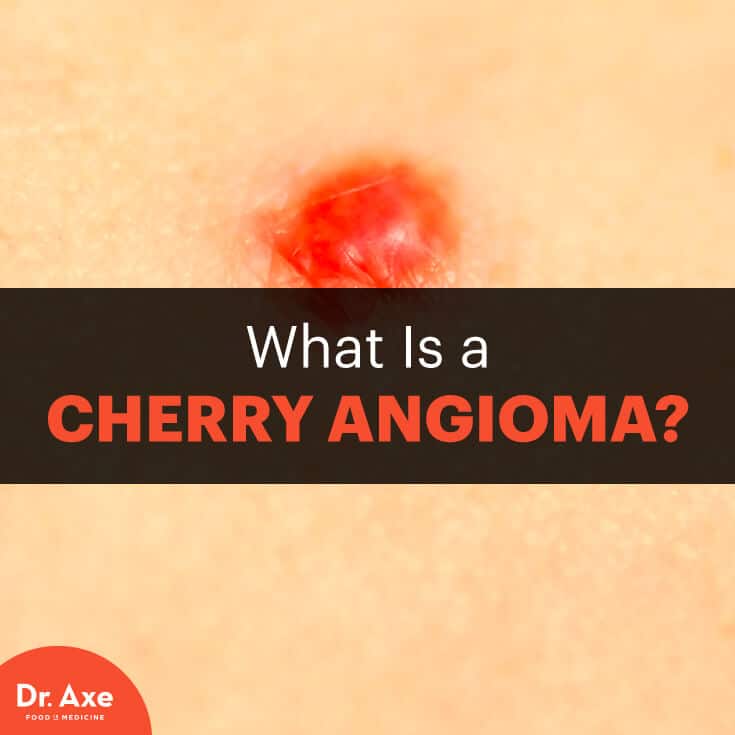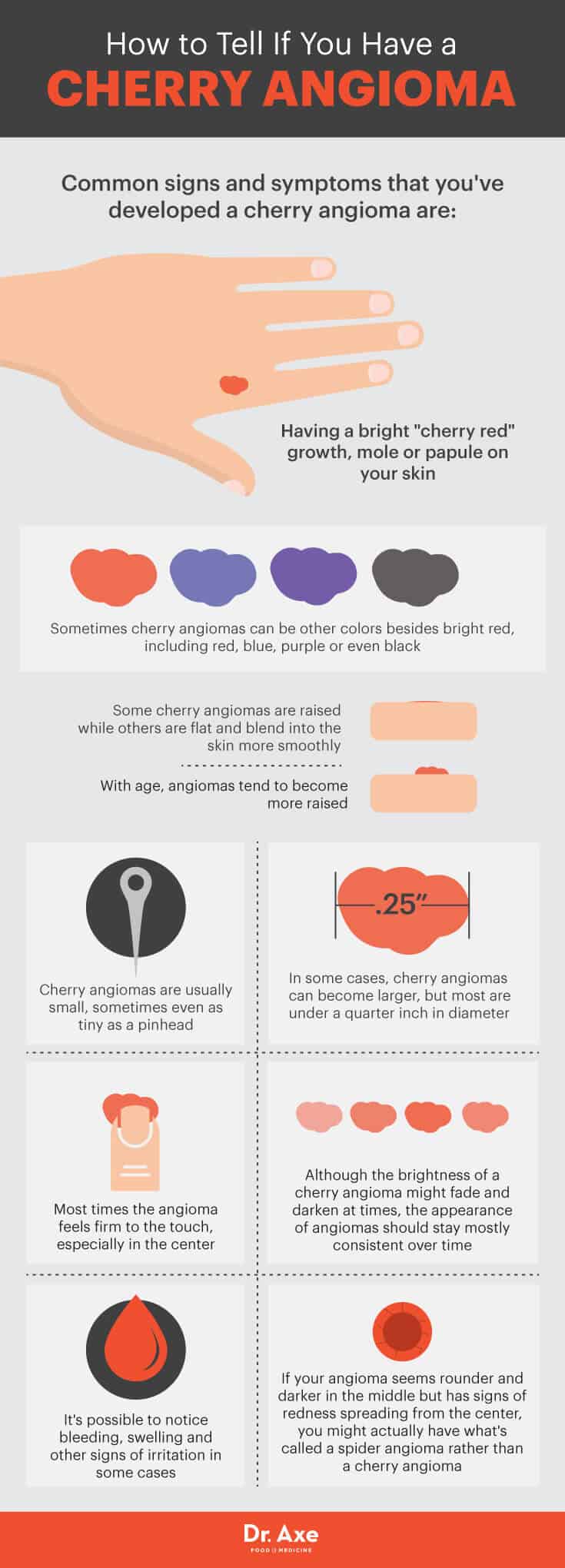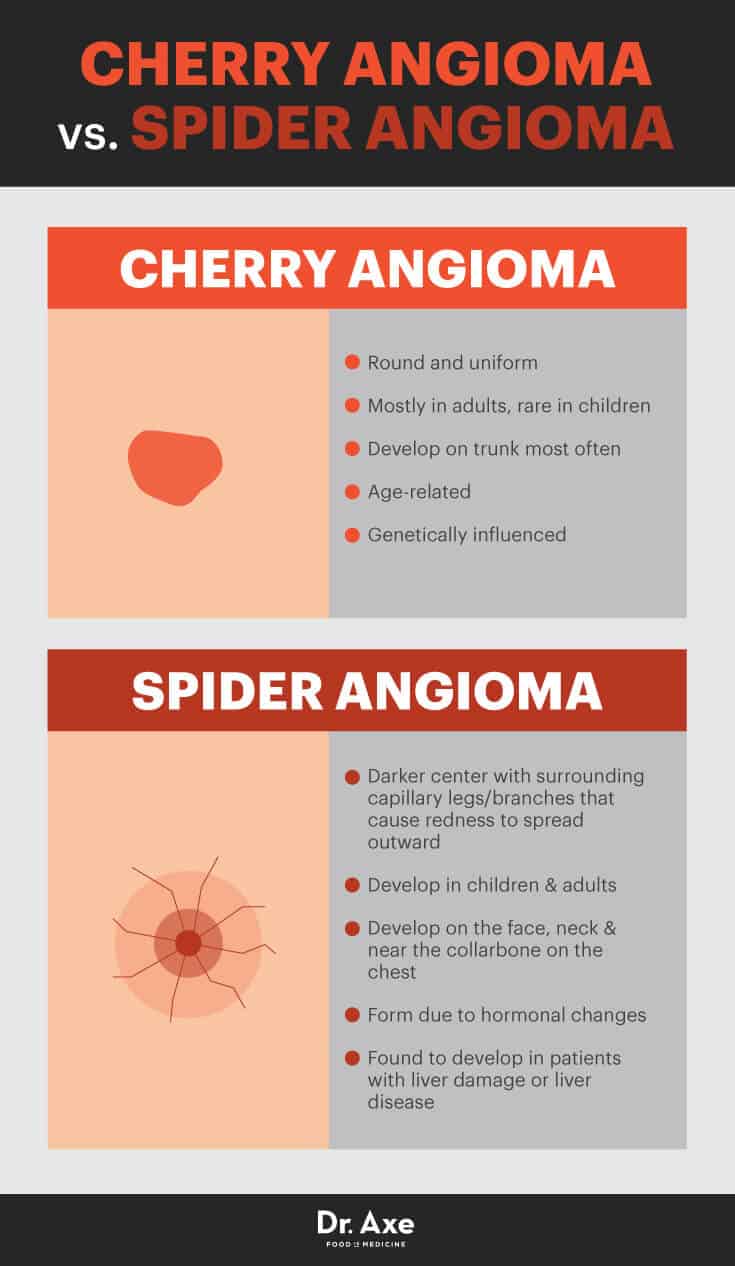
If you’ve never heard of a cherry angioma, chances are you’ve at least seen one — whether you know it or not. How do I know? Well, cherry angiomas are the most common type of angiomas, or benign tumors, adults develop on their skin.
How common? Some evidence shows that by the time someone reaches 70 years old, there’s about a 70 percent to 75 percent chance that person will have multiple cherry angiomas. (1) It’s much rarer for children to have cherry angiomas, as studies show that they’re observed in only 5 percent of adolescents.
What Is a Cherry Angioma?
Cherry angiomas are round (circular or oval) skin growths that appear bright red (hence the name cherry), are usually small in size, most commonly develop on the torso/trunk and most often are non-cancerous. According to a report published in Case Reports in Dermatology, they’re caused from tiny bulging blood vessels and abnormal proliferation of skin cells but usually don’t cause any pain or long-term health problems. (2)
Some people also refer to cherry angiomas as senile angiomas, capillary angioma, cherry hemangioma, Campbell de Morgan spots or simply cherry red skin papules/moles. Because most cherry angiomas are normally benign (non-cancerous) and not harmful, most doctors choose to leave them alone unless there’s reason for concern.
Adults over 30 years old are most likely to develop cherry angiomas, especially if they have family members who also suffer from similar skin papules. (3) Cherry angiomas affect people differently, varying in color and size, sometimes darkening with age or lightning depending on someone’s exposure to the sun, and in some people emerging in more than one location as they get older.
Cherry Angioma Symptoms
Due to their bright appearance, your doctor or dermatologist should be able to tell you have a cherry angioma without needing to do any extensive testing. While most people form cherry angiomas on the abdomen and trunk, it’s also possible for them develop on the shoulders, upper chest, scalp, face, neck and arms, especially with older age.
What do cherry angiomas look like? Common signs and symptoms that you’ve developed a cherry angioma are:
- Having a bright “cherry red” growth, mole or papule on your skin. Sometimes cherry angiomas can be other colors besides bright red, including red, blue, purple or even black.
- Some cherry angiomas are raised while others are flat and blend into the skin more smoothly. With age, angiomas tend to become more raised.
- Cherry angiomas are usually small, sometimes even as tiny as a pinhead. In some cases, cherry angiomas can become larger, but most are under a quarter inch in diameter.
- It’s possible to notice bleeding, swelling and other signs of irritation in some cases. This is most likely to occur if you scratch, pick or rub the angioma, or if you shave over it and break open the top layer.
- Most times the angioma feels firm to the touch, especially in the center.
- Although the brightness of a cherry angioma might fade and darken at times, the appearance of angiomas should stay mostly consistent over time. If you notice changes in size, texture or surrounding area (this goes for other skin growths, beauty marks or skin lesion as well), tell your doctor since this can be a sign of another problem.
- If your angioma seems rounder and darker in the middle but has signs of redness spreading from the center, you might actually have what’s called a spider angioma (more on this below) rather than a cherry angioma.

What Causes Cherry Angiomas? Risk Factors and Role of Genetics
The primary cause of cherry angiomas — as well as some other similar angiomas — is proliferating endothelial cells, which are cells that line the blood vessels. (4) The blood vessels that dilate and form angiomas are also called venules, which are small in size but can become red and swollen to the point of being very noticeable on the skin. When the blood vessels break open, the bright red color of cherry angiomas is the result. Skin papules are also made worse with age due to weakening of dermal capillary walls.
Why exactly this happens in some adults is not entirely known. Some evidence shows that genetics likely play a role in the development of angiomas, meaning if someone has a family history of related skin problems, that person is more likely to form cherry angiomas themselves.
Other risk factors for developing cherry angiomas include:
- Liver dysfunction, liver transplants or trouble processing chemicals (5)
- Hormonal changes or pregnancy
- Toxin and chemical exposure — There’s been case reports of patients developing multiple angiomas after contact with metals or products containing the element bromide. (6) Bromide has been linked to hormonal imbalances and certain endocrine dysfunctions and can be found in some pesticides, food additives and industrial products.
- Possibly due to sun exposure or certain weather conditions
Adults over 30 develop angiomas most often, and many find that the number of angiomas they develop only increases as they pass the age of 40. It’s common to notice cherry angiomas on the trunk first and years later to develop similar ones higher up on the body, such as on the chest and even face.
Conventional Treatment for Angiomas
You might be wondering if cherry angiomas can potentially be dangerous or a sign of a bigger problem, such as skin cancer, and how cherry angiomas normally are treated.
While most cherry angiomas are non-cancerous and unlikely to cause serious complications, in some cases it might be necessary to remove the growth and perform a biopsy to in order to be sure. Biopsy might involve an ultrasound scan, various methods of removing the angioma, and only rarely use of MRI or angiography.
The majority of patients with angiomas have the option of leaving the growths untreated and avoiding any sort of surgery. Sometimes patients choose to have an angioma removed because they don’t like the way it affects their appearance or they’re bothered by it bleeding from time to time, but this is usually a cosmetic choice rather than a health-related one.
If a patient does decide to have one removed for cosmetic reasons, insurance usually won’t cover the cost. The good news is that cherry angioma removal is usually relatively simple and straightforward, plus unlikely to leave a behind a scar. Options for having a cherry angioma removed include: (7)
- Shave excisions, which remove the angioma from the surface of the skin. Other options might be more effective because they remove a larger portion of the angioma cells from below the surface of the skin. However, one benefit of shave excisions is that they require less stitching or healing in most cases.
- Burning the growth off using electrosurgery
- Cryotherapy, which involves freezing the angioma very quickly. Some evidence shows this option is less likely to lead to infection during healing, plus it’s very fast.
- Laser treatments, which work through directing high heat right into the growth. Lasering angiomas can sometimes take several sessions, but each session is fast and usually not very painful.
Natural Treatments for Cherry Angioma
1. Apply Essential Oils (Especially Tea Tree Oil)
Tea tree oil has been safely used for centuries to improve many forms of skin irritation, rashes, discolorations and signs of inflammation. Tea tree is even safe to use on angiomas located near the neck and face, is often well-tolerated by those with sensitive skin, and is a very common ingredient in many beauty or skincare products. It’s been found to have natural antimicrobial properties, kills fungus and bacteria that can live on the skin and contribute to irritation, reduces chance for infection if you have an angioma removed, and can help prevent bruising from bleeding.
Other essential oils that are used in commercial angioma products (typically sold online and applied to the skin through a roller ball) are chamomile essential oil, lavender oil, orange oil and pelargonium leaf oil.
To use these oils on your skin, mix one teaspoon of coconut oil (which serves a carrier oil to further help prevent irritation) with five to 10 drops of mixed oils (especially tea tree oil and lavender essential oil). Store the mixture at room temperature and apply it to the skin several times daily. This can also be used on the scalp and face in most patients without side effects, as well as for numerous other skin conditions.
2. Limit Chemical Exposure (Especially Bromide)
Because bromide exposure has been linked to the development of cherry angiomas, you might have a higher chance of having this skin condition if you frequently come into contact with high amounts of pesticides sprayed on non-organic crops or synthetic food products containing things like brominated flour and/or texture enhancers.
Bromide has also been associated with hormonal changes and thyroid dysfunction, as demonstrated in studies showing that bromide can decrease the amount of iodide accumulated in the thyroid, change the proportion between the amount of iodine retained in the thyroid and the total amount of absorbed iodine, and shorten the half-life of iodine in the thyroid, which is needed for proper hormone production. (8) Some believe that increasing intake of iodine might be able to help treat formation of angiomas, although this hasn’t been proven. A safe way to improve thyroid health without overconsuming iodine is to consume more foods with natural iodine like sea vegetables, spirulina, cranberries, salmon, eggs, yogurt, prunes and strawberries.
Bromide can be found in a type of processed vegetable oil known as BVO, certain soft drinks containing oily substances or syrups, and in processed foods like bread or commercial bakery products. Brominated flour is a common ingredient in products containing enriched flour and is used to add stretch and “mouth-feel” to packaged grains that are left sitting on shelves for long period. Because of its chemical composition, bromide is even used in some pool/hot tub cleaning products, fire retardants and coatings of certain medications.
Some steps you can take to help lower your exposure to chemicals such as bromide include:
- Purchasing organic produce as much as possible.
- Avoiding processed grain products made with enriched flours.
- Not drinking soft drinks stored in aluminum cans or plastic bottles.
- Avoiding using household and personal care products that are not organic, natural and free from added chemicals.
- Avoiding harsh chemicals in industrial cleaners and chlorine products.
- Talking to your doctor about your medication use if you regularly take any of following: inhalers or nasal sprays, medications for ulcers, topical numbing agents, or anesthesias.
3. Try Apple Cider Vinegar
Some have found that applying apple cider vinegar (the pure kind that’s fermented and not distilled) to cherry angiomas can reduce their appearance. ACV contains the active ingredient called acetic acid, which is associated with multiple skin benefits, including cleansing, toning, and preventing acne or rashes.
To try this method, dip a clean cotton ball or piece of fabric into ACV, press it against the angioma, and hold it in place for 10–30 minutes. Most have found that doing this twice daily for several weeks offers the best results. If you notice swelling, bruising and other signs of irritation around the angioma, ACV may be able to help you avoid surgical removal by improving the angioma’s noticeability and appearance.
4. Improve Liver Health and Hormonal Balance Through Detoxification
Because hormonal fluctuations, thyroid hormone changes, estrogen dominance and poor liver health have all been associated with the formation of cherry angiomas, improving your body’s ability to detoxify itself of waste might help prevent future angiomas. Ways you can improve detoxification are:
- Consuming plenty high-antioxidant foods, including those with a bitter taste like leafy greens (remember to purchase organic!).
- Drinking homemade vegetable juices or green smoothies.
- Using natural skin care products.
- Not smoking or using tobacco products.
- Considering avoiding use of birth control pills, hormone replacement drugs or any unnecessary medications.

Cherry Angioma vs. Hemangioma and Other Types of Angiomas
- Another name for cherry angiomas is hemangioma. Most of the time when people talk about hemangioma, they’re referring to the same thing as a cherry angioma or another type of angioma that’s similar.
- Other than cherry angiomas, adults and children can develop related skin papules or moles called venous angiomas and spider angiomas.
- People sometimes confuse cherry angiomas with spider angioma (spider naevi). One primary difference between the two is that cherry angiomas tend to be somewhat round and uniform looking, but spider angiomas usually have a darker center along with surrounding capillary legs/branches that cause redness to spread outward. Venous angiomas, on the other hand, develop on the lips and tend to form a dark red, purple or blue bump.
- Another difference between cherry and spider angiomas is whom they tend to affect and what part of the body they develop on. Spider angiomas can develop in children as well as adults, but it’s rare for a child to have a cherry angioma. Cherry angiomas develop on the trunk most often, while spider angiomas tend to develop on the face, neck and near the collarbone on the chest.
- Cherry angiomas are age-related and believed to be genetically influenced, but evidence shows that spider angiomas form due to hormonal changes in many cases, such as increased levels of estrogen during puberty or pregnancy. They’ve also been found to develop in patients with liver damage or liver disease.
Cherry Angioma vs. Skin Cancer: How to Tell the Difference
- Unlike skin cancer growths, most angiomas are harmless. In other words cherry hemangioma itself has no connection to cancer, although this doesn’t mean that someone with an angioma cannot have skin cancer in another location.
- Rarely an angioma can contain malignant cells or contain a tiny lesion that’s found to be cancerous melanoma. If this is suspected, a biopsy will be performed, sometimes along with other precautionary measures.
- The most important thing to do to prevent skin cancer from going unnoticed or untreated is to pay attention to changes in appearance of skin growths, as well as keeping up with regular doctor’s visits. To be safe, always track appearance of growths, moles or freckles that form on your skin as you age, informing your doctor if you ever notice changes in appearance (size, color, texture, etc.) or bleeding.
- Visit your dermatologist regularly for a skin check in which your doctor will scan over any growths to look for potential signs or symptoms of skin cancer, including melanoma. Signs of skin cancer can include increasing mole diameter, darkening of the skin, mole color changes, or skin moles that have irregular borders and shapes.
Precautions When Treating Cherry Angioma
It’s best not to assume that cherry angiomas are the definitive reason for red patches forming on your skin. There are many reasons that red spots or growths can appear on the skin, including hormonal changes, rosacea, allergies, dermatitis and others. If you notice papules on your skin for the first time, especially if they’re bleeding often or are painful, mention this to your doctor in order to be sure there’s not another cause.
If you have sensitive skin or an allergy to any of the home remedies mentioned above (apple cider vinegar, for example, or essential oils), don’t use these products on your skin, and get your dermatologist’s advice regarding safer treatment options instead.
Also be cautious regarding advice to burn off angiomas on your own at home. Some patients are able to safely burn cherry angiomas using heated pins or needles, but there are always risks involved. This can sometimes be painful, lead to infections, or leave behind marks and scars. A better idea is having an angioma removed professionally and safely by a dermatologist in a professional setting.
Final Thoughts on Cherry Angioma
- Cherry angiomas are common, bright red skin papules or moles that usually develop on the skin of adults but are non-cancerous and usually not harmful.
- Signs of a cherry angioma are developing a small, either flat or raised skin growth that is dark red, blue, purple or black, most often on the trunk or chest.
- Natural treatments for cherry angiomas include treating the area with tea tree essential oil and other concentrated oils, applying apple cider vinegar, and reducing toxin exposure. You can also consider professional removal through freezing, laser therapy, burning or shaving performed at a dermatologist office.